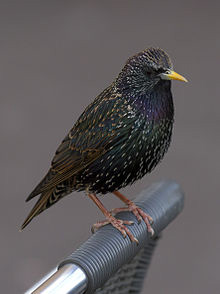Starlings and all that racket
There are a ton of mulberry trees along the bayou. They bear sweet black berries (that look kind of like blackberries) in the spring. They are a very important food source for wild critters. They are also a decent food source for us more civilized critters, too.
Right now, the European Starlings are feasting on mulberries and making a god-awful racket. This sound clip is what you can hear all along the bayou. I don’t remember hearing this noise so constantly before. Maybe I just ignored it or assumed it was made by insects. I’m fascinated by it. This isn’t the Starlings’ song, it is their call. Birds are born knowing their species call. It is wired into their brains. They have to learn their songs, though. Usually, only male birds sing. Females of some species will sing, but singing is really a boy thing and they have to learn it from their dad. It’s an important job and he will hang around the nest long enough to teach his sons his song. Studies with Chaffinches in England suggest that while dad teaches the basics of his song, it takes almost another 11 months of listening to other birds of their species for the boys to master the art of singing. They are ready to go when the next breeding season starts. This is fortunate timing because singing is all about breeding. It is how male birds establish territory and attract a mate. Because birds learning to sing is kind of like a game of telephone passed from one to another, the exact song each bird sings can be somewhat idiosyncratic. Regional accents are commonplace.

This Starling shows the lovely white spots for which the bird is named. They look like a night sky full of stars. By the end of the summer, most of the spots will be gone. Each feather is tipped in white and the tips wear off over time. But once the birds molt in fall, the stars will return.
While song is almost entirely about breeding, calls are full of communication. They let a flock know where each bird is, calls can sound alarms and can be very specific. There is one call for a predator nearby another for a predator overhead.
The racket the Starlings are making right now involves babies begging for food. Birds that can’t fly are easy prey for everything around them that is hungry. So baby birds get their feathers long before they get their brains. That’s why you see what look like full-grown birds feeding other full-grown birds. The ones getting fed have only the appearance of full-grown birds; they are really helpless babies. The only reason they aren’t dead babies is that they have feathers and can fly to safety.
Starling songs are not very melodic even though they are amazing mimics. A friend once raised one from a chick (the bird was blind). This bird put parrots to shame its vocabulary was so large. We don’t hear them singing other songs so much in the wild here. Not like Mockingbirds who have no song of their own but mimic the songs of other birds so well that birders have to pay attention to whether or not the song they are hearing repeats more than three times. A Mockingbird will not repeat a song more than three times; the bird to whom the song actually belongs will sing it endlessly.
Both Mockingbirds and Starlings are amazing mimics, and both have horrid-sounding calls. Mockingbirds’ call is a guttural hiss and their babies cry out with a sound that is like a hinge desperate for oil. The Starling call is that irritating clamor you can play for yourself in the clip above or just take a walk anywhere near a mulberry tree right now. It amuses me to imagine that they make up for their calls (about which they can do nothing because they have no choice about the call) by choosing to imitate sounds that are melodic. But that would not be a reasonable thought for a naturalist to have.

